
A submarine sandwich, commonly known as a sub, hoagie, hero, Italian, grinder, wedge, or a spuckie, is a type of American cold or hot sandwich made from a cylindrical bread roll split lengthwise and filled with meats, cheeses, vegetables, and condiments.

A sandwich is a food typically consisting of vegetables, sliced cheese or meat, placed on or between slices of bread, or more generally any dish wherein bread serves as a container or wrapper for another food type. The sandwich began as a portable, convenient finger food in the Western world, though over time it has become prevalent worldwide.
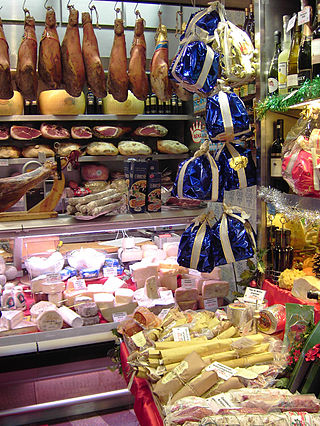
Traditionally, a delicatessen or deli is a retail establishment that sells a selection of fine, exotic, or foreign prepared foods. Delicatessens originated in Germany during the 18th century and spread to the United States in the mid-19th century. European immigrants to the United States, especially Ashkenazi Jews, popularized the delicatessen in U.S. culture beginning in the late 19th century. Today, many large retail stores like supermarkets have deli sections.

An open sandwich, also known as an open-face/open-faced sandwich, bread baser, bread platter or tartine, consists of a slice of bread or toast with one or more food items on top. It has half the number of slices of bread compared to a typical closed sandwich.
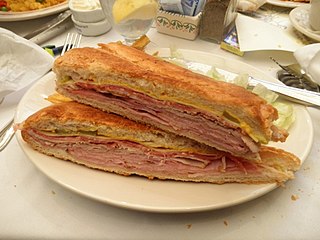
A Cuban sandwich is a variation of a ham and cheese sandwich that likely originated in cafes catering to Cuban workers in Tampa or Key West, two early Cuban immigrant communities in Florida centered on the cigar industry. Later on, Cuban exiles and expatriates brought it to Miami, where it is also very popular. The sandwich is made with ham, (mojo) roasted pork, Swiss cheese, pickles, mustard, and sometimes salami on Cuban bread. Salami is included in Tampa, where there is a large Italian population, but is not usually included in South Florida.

A Dagwood sandwich is a tall, multilayered sandwich made with a variety of meats, cheeses, and condiments. It is named after Dagwood Bumstead, a central character in the comic strip Blondie, who is frequently illustrated making enormous sandwiches. According to Blondie scripter Dean Young, his father, Chic Young, began drawing the huge sandwiches in the comic strip in 1936.

The horseshoe is an open-faced sandwich originating in Springfield, Illinois, United States. It consists of thick-sliced toasted bread, a hamburger patty or other choice of meat, French fries, and cheese sauce.

A po' boy is a sandwich originally from Louisiana. It traditionally consists of meat, which is usually roast beef, ham, or fried seafood such as shrimp, crawfish, fish, oysters, or crab. The meat is served in New Orleans French bread, known for its crisp crust and fluffy center.
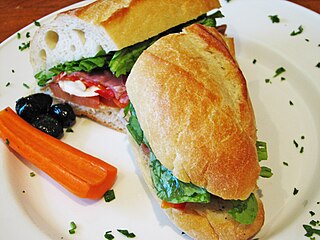
A panini is a sandwich made with Italian bread, usually served warm after grilling or toasting.

A breakfast sandwich is any sandwich filled with foods associated with breakfast. Breakfast sandwiches are served at fast food restaurants and delicatessens, sold in supermarkets, or commonly made at home. Different types of breakfast sandwich include the bacon sandwich, the egg sandwich, and the sausage sandwich; or various combinations thereof, like the bacon, egg and cheese sandwich. The breakfast sandwich is related to the breakfast roll.
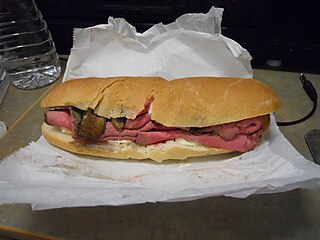
The roast beef sandwich is a sandwich that is made out of sliced roast beef or sometimes beef loaf. It is sold at many diners in the United States, as well as fast food chains, such as Arby's, Rax Roast Beef, and Roy Rogers Restaurants. This style of sandwich often comes on a hamburger bun and may be topped with barbecue sauce and/or melted American cheese. The roast beef sandwich also commonly comprises bread, cold roast beef, lettuce, tomatoes, and mustard, although it would not be uncommon to find cheese, horseradish, fresh/powdered chili pepper and even in some cases red onion. Roast beef sandwiches may be served hot or cold, and are sometimes served open faced.

The bocadillo or bocata, in Spain, is a sandwich made with Spanish bread, usually a baguette or similar type of bread, cut lengthwise. Traditionally seen as a humble food, its low cost has allowed it to evolve over time into an iconic piece of cuisine. In Spain, they are often eaten in cafes and tapas bars.

The cheese dream is an open-faced version of the American grilled cheese sandwich made with bread and cheese; it is cooked with either oil, margarine, or butter. Other ingredients such as bacon, avocado, pineapple, eggs, or sliced tomato can be optionally added to the open-faced sandwich as well.

Francesinha poveira, or simply francesinha, is a fast food dish from Póvoa de Varzim in Portugal. It resembles a hot dog only in shape, but the sandwich is made of linguiça, fiambre, cheese and mustard in pão cacete or pão de francesinha, a type of bread that could be described as midway between a baguette and a hot dog bun.
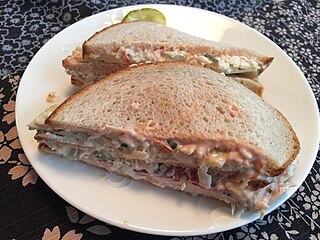
Throughout most of northern New Jersey, a sloppy joe is a cold delicatessen sandwich. There are minor variations depending on the deli, but it is always a double-decker thin sliced rye bread sandwich made with one or more types of sliced deli meat, such as turkey, ham, pastrami, corned beef, roast beef, or sliced beef tongue, along with Swiss cheese, coleslaw, and Russian dressing.

The cuisine of St. Louis is largely influenced by the city’s German, Irish, Italian, Mexican, Chinese, and Vietnamese immigrant population and African Americans who migrated from the Southern United States.

Obložený chlebíček or just Chlebíček is a dish in Czech and Slovak cuisines also common in other former Austro-Hungarian countries. It is a type of open sandwich with various toppings and garnishes. It is often served as an appetizer dish or as a snack.

American Jewish cuisine comprises the food, cooking, and dining customs associated with American Jews. It was heavily influenced by the cuisine of Jewish immigrants who came to the United States from Eastern Europe around the turn of the 20th century. It was further developed in unique ways by the immigrants and their descendants, especially in New York City and other large metropolitan areas of the northeastern U.S.


















